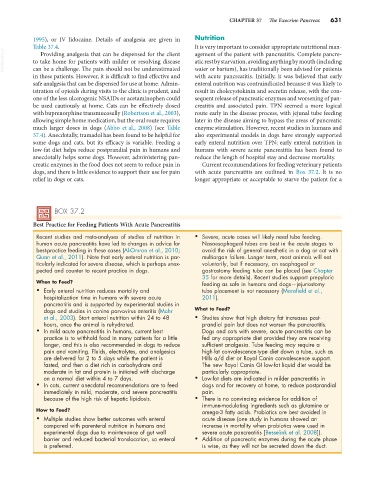Page 659 - Small Animal Internal Medicine, 6th Edition
P. 659
CHAPTER 37 The Exocrine Pancreas 631
1995), or IV lidocaine. Details of analgesia are given in Nutrition
Table 37.4. It is very important to consider appropriate nutritional man-
VetBooks.ir to take home for patients with milder or resolving disease agement of the patient with pancreatitis. Complete pancre-
Providing analgesia that can be dispensed for the client
atic rest by starvation, avoiding anything by mouth (including
can be a challenge. The pain should not be underestimated
with acute pancreatitis. Initially, it was believed that early
in these patients. However, it is difficult to find effective and water or barium), has traditionally been advised for patients
safe analgesia that can be dispensed for use at home. Admin- enteral nutrition was contraindicated because it was likely to
istration of opioids during visits to the clinic is prudent, and result in cholecystokinin and secretin release, with the con-
one of the less ulcerogenic NSAIDs or acetaminophen could sequent release of pancreatic enzymes and worsening of pan-
be used cautiously at home. Cats can be effectively dosed creatitis and associated pain. TPN seemed a more logical
with buprenorphine transmucosally (Robertson et al., 2003), route early in the disease process, with jejunal tube feeding
allowing simple home medication, but the oral route requires later in the disease aiming to bypass the areas of pancreatic
much larger doses in dogs (Abbo et al., 2008) (see Table enzyme stimulation. However, recent studies in humans and
37.4). Anecdotally, tramadol has been found to be helpful for also experimental models in dogs have strongly supported
some dogs and cats, but its efficacy is variable. Feeding a early enteral nutrition over TPN; early enteral nutrition in
low-fat diet helps reduce postprandial pain in humans and humans with severe acute pancreatitis has been found to
anecdotally helps some dogs. However, administering pan- reduce the length of hospital stay and decrease mortality.
creatic enzymes in the food does not seem to reduce pain in Current recommendations for feeding veterinary patients
dogs, and there is little evidence to support their use for pain with acute pancreatitis are outlined in Box 37.2. It is no
relief in dogs or cats. longer appropriate or acceptable to starve the patient for a
BOX 37.2
Best Practice for Feeding Patients With Acute Pancreatitis
Recent studies and meta-analyses of studies of nutrition in • Severe, acute cases will likely need tube feeding.
human acute pancreatitis have led to changes in advice for Nasoesophageal tubes are best in the acute stages to
best-practice feeding in these cases (Al-Omran et al., 2010; avoid the risk of general anesthetic in a dog or cat with
Quan et al., 2011). Note that early enteral nutrition is par- multiorgan failure. Longer term, most animals will eat
ticularly indicated for severe disease, which is perhaps unex- voluntarily, but if necessary, an esophageal or
pected and counter to recent practice in dogs. gastrostomy feeding tube can be placed (see Chapter
35 for more details). Recent studies support prepyloric
When to Feed? feeding as safe in humans and dogs—jejunostomy
• Early enteral nutrition reduces mortality and tube placement is not necessary (Mansfield et al.,
hospitalization time in humans with severe acute 2011).
pancreatitis and is supported by experimental studies in
dogs and studies in canine parvovirus enteritis (Mohr What to Feed?
et al., 2003). Start enteral nutrition within 24 to 48 • Studies show that high dietary fat increases post-
hours, once the animal is rehydrated. prandial pain but does not worsen the pancreatitis.
• In mild acute pancreatitis in humans, current best Dogs and cats with severe, acute pancreatitis can be
practice is to withhold food in many patients for a little fed any appropriate diet provided they are receiving
longer, and this is also recommended in dogs to reduce sufficient analgesia. Tube feeding may require a
pain and vomiting. Fluids, electrolytes, and analgesics high-fat convalescence-type diet down a tube, such as
are delivered for 2 to 5 days while the patient is Hills a/d diet or Royal Canin convalescence support.
fasted, and then a diet rich in carbohydrate and The new Royal Canin GI low-fat liquid diet would be
moderate in fat and protein is initiated with discharge particularly appropriate.
on a normal diet within 4 to 7 days. • Low-fat diets are indicated in milder pancreatitis in
• In cats, current anecdotal recommendations are to feed dogs and for recovery at home, to reduce postprandial
immediately in mild, moderate, and severe pancreatitis pain.
because of the high risk of hepatic lipidosis. • There is no convincing evidence for addition of
immune-modulating ingredients such as glutamine or
How to Feed? omega-3 fatty acids. Probiotics are best avoided in
• Multiple studies show better outcomes with enteral acute disease (one study in humans showed an
compared with parenteral nutrition in humans and increase in mortality when probiotics were used in
experimental dogs due to maintenance of gut wall severe acute pancreatitis [Besselink et al. 2008]).
barrier and reduced bacterial translocation, so enteral • Addition of pancreatic enzymes during the acute phase
is preferred. is wise, as they will not be secreted down the duct.

